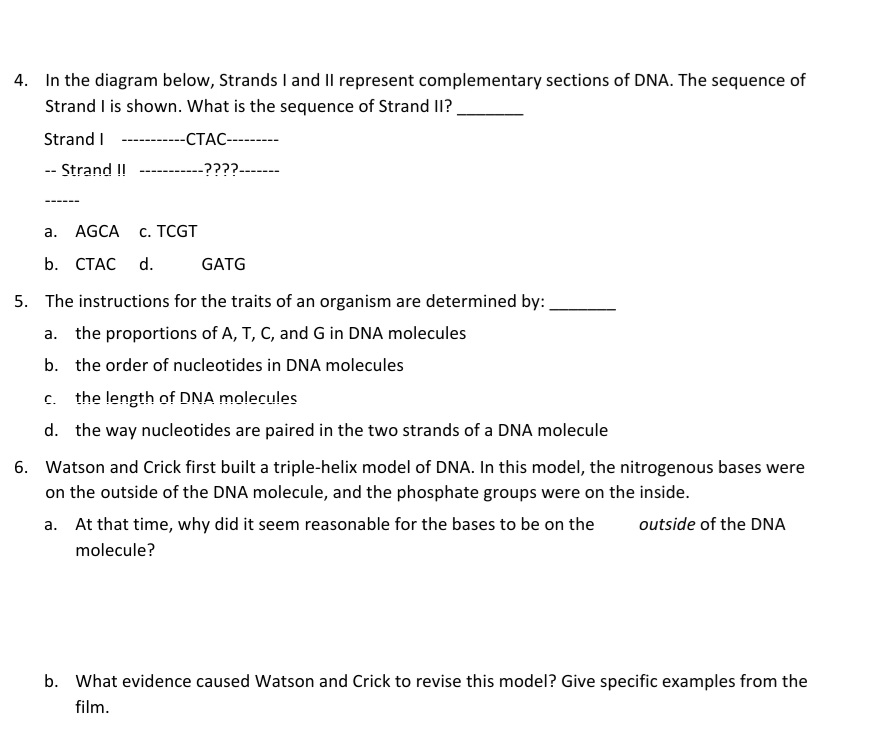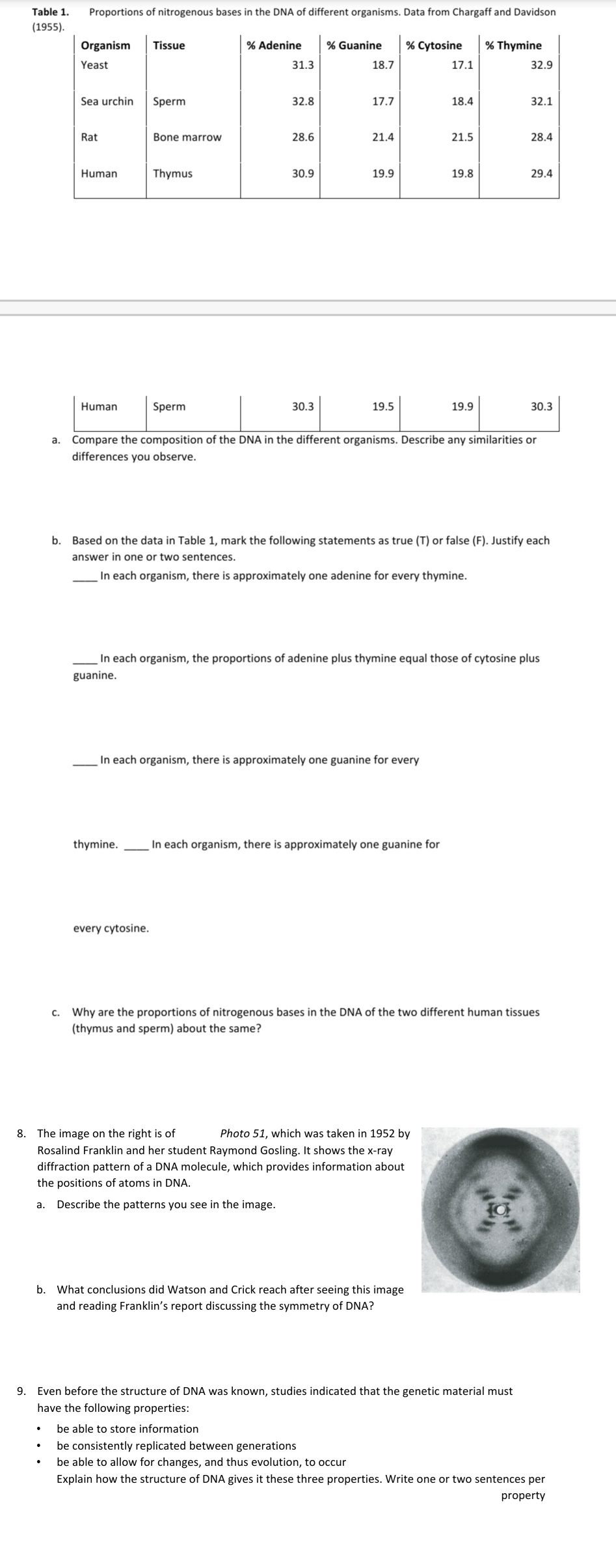In the diagram below, Strands I and II represent complementary sections of DNA. The sequence of Strand I is shown. What is the sequence of Strand II? Strand -- Strand II ---CTAC--------- -????-- a. AGCA c. TCGT b. CTAC d. GATG The instructions for the traits of an organism are determined by: a. the proportions of A, T, C, and G in DNA molecules b. the order of nucleotides in DNA molecules c. the length of DNA molecules d. the way nucleotides are paired in the two strands of a DNA molecule
In the diagram below, Strands I and II represent complementary sections of DNA. The sequence of Strand I is shown. What is the sequence of Strand II? Strand -- Strand II ---CTAC--------- -????-- a. AGCA c. TCGT b. CTAC d. GATG The instructions for the traits of an organism are determined by: a. the proportions of A, T, C, and G in DNA molecules b. the order of nucleotides in DNA molecules c. the length of DNA molecules d. the way nucleotides are paired in the two strands of a DNA molecule
Biology (MindTap Course List)
11th Edition
ISBN:9781337392938
Author:Eldra Solomon, Charles Martin, Diana W. Martin, Linda R. Berg
Publisher:Eldra Solomon, Charles Martin, Diana W. Martin, Linda R. Berg
Chapter16: Human Genetics And The Human Genome
Section: Chapter Questions
Problem 12TYU: SCIENCE, TECHNOLOGY, AND SOCIETY Imagine that you are a genetic counselor. What advice or...
Related questions
Question

Transcribed Image Text:4. In the diagram below, Strands I and II represent complementary sections of DNA. The sequence of
Strand I is shown. What is the sequence of Strand II?
Strand I
-- Strand !!
-CTAC---------
-????-------
a. AGCA c. TCGT
b. CTAC d.
GATG
5. The instructions for the traits of an organism are determined by:
a.
the proportions of A, T, C, and G in DNA molecules
b. the order of nucleotides in DNA molecules
C.
the length of DNA molecules
d. the way nucleotides are paired in the two strands of a DNA molecule
6. Watson and Crick first built a triple-helix model of DNA. In this model, the nitrogenous bases were
on the outside of the DNA molecule, and the phosphate groups were on the inside.
outside of the DNA
a. At that time, why did it seem reasonable for the bases to be on the
molecule?
b. What evidence caused Watson and Crick to revise this model? Give specific examples from the
film.

Transcribed Image Text:Table 1.
(1955).
a.
Proportions of nitrogenous bases in the DNA of different organisms. Data from Chargaff and Davidson
Organism
Yeast
.
Sea urchin Sperm
Rat
Human
Human
Tissue
Bone marrow
Thymus
thymine.
Sperm
every cytosine.
% Adenine
31.3
32.8
28.6
30.9
30.3
% Guanine
18.7
17.7
21.4
19.9
19.5
% Cytosine % Thymine
In each organism, there is approximately one guanine for every
17.1
In each organism, there is approximately one guanine for
18.4
8. The image on the right is of
Photo 51, which was taken in 1952 by
Rosalind Franklin and her student Raymond Gosling. It shows the x-ray
diffraction pattern of a DNA molecule, which provides information about
the positions of atoms in DNA.
a. Describe the patterns you see in the image.
b. What conclusions did Watson and Crick reach after seeing this image
and reading Franklin's report discussing the symmetry of DNA?
21.5
19.8
19.9
Compare the composition of the DNA in the different organisms. Describe any similarities or
differences you observe.
b. Based on the data in Table 1, mark the following statements as true (T) or false (F). Justify each
answer in one or two sentences.
In each organism, there is approximately one adenine for every thymine.
In each organism, the proportions of adenine plus thymine equal those of cytosine plus
guanine.
32.9
32.1
28.4
X
9. Even before the structure of DNA was known, studies indicated that the genetic material must
have the following properties:
29.4
30.3
C. Why are the proportions of nitrogenous bases in the DNA of the two different human tissues
(thymus and sperm) about the same?
be able to store information
be consistently replicated between generations
be able to allow for changes, and thus evolution, to occur
Explain how the structure of DNA gives it these three properties. Write one or two sentences per
property
Expert Solution
This question has been solved!
Explore an expertly crafted, step-by-step solution for a thorough understanding of key concepts.
This is a popular solution!
Trending now
This is a popular solution!
Step by step
Solved in 2 steps

Knowledge Booster
Learn more about
Need a deep-dive on the concept behind this application? Look no further. Learn more about this topic, biology and related others by exploring similar questions and additional content below.Recommended textbooks for you

Biology (MindTap Course List)
Biology
ISBN:
9781337392938
Author:
Eldra Solomon, Charles Martin, Diana W. Martin, Linda R. Berg
Publisher:
Cengage Learning

Biology: The Dynamic Science (MindTap Course List)
Biology
ISBN:
9781305389892
Author:
Peter J. Russell, Paul E. Hertz, Beverly McMillan
Publisher:
Cengage Learning

Biology 2e
Biology
ISBN:
9781947172517
Author:
Matthew Douglas, Jung Choi, Mary Ann Clark
Publisher:
OpenStax

Biology (MindTap Course List)
Biology
ISBN:
9781337392938
Author:
Eldra Solomon, Charles Martin, Diana W. Martin, Linda R. Berg
Publisher:
Cengage Learning

Biology: The Dynamic Science (MindTap Course List)
Biology
ISBN:
9781305389892
Author:
Peter J. Russell, Paul E. Hertz, Beverly McMillan
Publisher:
Cengage Learning

Biology 2e
Biology
ISBN:
9781947172517
Author:
Matthew Douglas, Jung Choi, Mary Ann Clark
Publisher:
OpenStax

Biology: The Unity and Diversity of Life (MindTap…
Biology
ISBN:
9781305073951
Author:
Cecie Starr, Ralph Taggart, Christine Evers, Lisa Starr
Publisher:
Cengage Learning